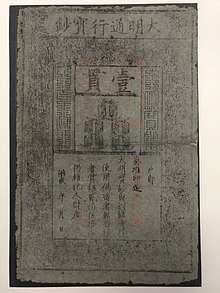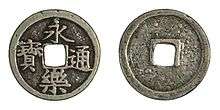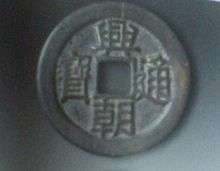Ming dynasty coinage

Chinese coinage in the Ming dynasty saw the production of many types of coins. During the Ming dynasty of China, the national economy was developed and its techniques of producing coinage were advanced. One early period example is the Bronze 1 cash. Obverse: "HUNG-WU T'UNG-P'AO" (洪武通寶). Reverse: blank. Average (18 specimens) 23.8 mm, 3.50 grams (the weight vary considerable and we have records of specimens from 2.2 to 4.1 grams).
Background

Zhu Yuanzhang, better known as the Hongwu Emperor, proclaimed the Ming in 1368. It was originally based at Yingtian (now Nanjing) before being moved to Beijing by the Yongle Emperor in 1421.
From the founding of Ming until 1450, the emperors attempted to use paper currency, but this experienced the same hyperinflation as its predecessors. For the most part, the country was starved for silver in the early part of the dynasty and much trade occurred via barter; in later years, silver from Japan and Spain (through the Manila Galleon) flowed into the country and was traded as bullion now known as sycee. However, the emperors also periodically minted coins.[1] Alongside copper coins cowrie shells continued to circulate during this period as well.[2]
Coinage in the Ming era
After the Chinese became independent following the retreat of the Mongols back north and a bloody civil war culminating with the victory of Zhu Yuanzhang the Ming dynasty rose to power and under it a long period of stability and growth came. Until 1505 cash coins circulated alongside the Da Ming Baochao banknotes, but as more silver currency entered the Chinese market other currencies such as Spanish dollars started supplanting cash coins. Privately minted cash coins of inferior quality became predominant in the south of China and 4 types of official cash coins were minted of varying quality of which one time with a weight of 1 qián was cast for payment to the imperial government, a second type of 0.9 qián for the salaries of officials, and the two types of lowest quality were mostly used by the commoners and circulated the most. Coins known as gold reverse coins were cast that were smelted four times as opposed to two and these were regarded as being more valuable, ironically because of this these gold reverse coins were being hoarded which prevented them from circulating causing even cheap and low quality counterfeit cash coins to circulate in larger numbers, after the government of the Ming dynasty started producing "milled rim" cash coins these were universally accepted so fast that at one point merchants accepted only these coins, but as the reputation of the gold reverse cash coins was so strong the "milled rim" coins were eventually viewed as worthless and deprecated.[3]
Usually, Chinese money is a round coin with a square hole in the center. On the obverse side, there are usually words indicating the emperor's reign name or era name. On the reverse side, there are words or graphic patterns often indicating denomination or a mint mark. It is also possible there is nothing on the reverse side. In the early period of the Ming dynasty, though, there were many different types of coin. Examples include:[4]
- "Da Zhong Tong Bao" (traditional Chinese: 大中通寶; simplified Chinese: 大中通宝)
- "Hong Wu Tong Bao" (traditional Chinese: 洪武通寶; simplified Chinese: 洪武通宝)
- "Hong Xi Tong Bao" (traditional Chinese: 洪熙通寶; simplified Chinese: 洪熙通宝)
- "Yong Le Tong Bao" (traditional Chinese: 永樂通寶; simplified Chinese: 永乐通宝)
- "Zheng De Tong Bao" (traditional Chinese: 正德通寶; simplified Chinese: 正德通宝)
- "Hong Zhi Tong Bao" (traditional Chinese: 弘治通寶; simplified Chinese: 弘治通宝)
- "Jia Jing Tong Bao" (traditional Chinese: 嘉靖通寶; simplified Chinese: 嘉靖通宝)
- "Jia Jing An Bao" (traditional Chinese: 嘉靖安寶; simplified Chinese: 嘉靖安宝)
- "Wan Li Nian Zao" (traditional Chinese: 萬曆年造; simplified Chinese: 万历年造)
- "Wan Li Tong Bao" (traditional Chinese: 萬曆通寶; simplified Chinese: 万历通宝)
- "Tian Qi Tong Bao" (traditional Chinese: 天啟通寶; simplified Chinese: 天启通宝)
- "Chong Zhen Tong Bao" (traditional Chinese: 崇禎通寶; simplified Chinese: 崇祯通宝)
Most of the coinage names are derived from the titles of the reigns during which they were produced. For example,"Hong Wu Tong Bao" was produced during the Hongwu years (1368—1398).[5] No coins with the inscription Zheng De Tong Bao (正德通寶) were ever produced for circulation by the Zhengde Emperor, however during the late Ming, and early Qing era many "lucky charms" with this inscription were produced, but these usually contain more decorative reverses featuring various auspicious depictions.
Guizhou local issues
During the Hongzhi period from 1488 until 1505 some Tribal Commissioners in the province of Guizhou issued their own cash coins, rather than being bases on reign titles the inscriptions were based on place names.[6][7]
| Inscription | Traditional Chinese | Simplified Chinese | Emperor | Image |
|---|---|---|---|---|
| Shuiguan Tongbao | 水官通寶 | 水官通宝 | Hongzhi Emperor | _-_Guizhou_local_issue_-_Scott_Semans.jpg) |
| Taiguan Tongbao | 太官通寶 | 太官通宝 | Hongzhi Emperor | |
| Huoguan Tongbao | 火官通寶 | 火官通宝 | Hongzhi Emperor | |
| Dading Tongbao | 大定通寶 | 大定通宝 | Hongzhi Emperor | _-_Guizhou_local_issue_-_Scott_Semans.jpg) |
| Taiding Tongbao | 太定通寶 | 太定通宝 | Hongzhi Emperor | |
| Taizi Tongbao | 太子通寶 | 太子通宝 | Hongzhi Emperor |
Words on the coinage
During the transitional period between Ming and Qing, various rebels and pretenders made their own money with different Chinese characters on it. Usually, there are four words on each side of a coin.[8][9]
| Chinese characters on the Coinage in Pinyin | Traditional Chinese | Simplified Chinese | Producer |
|---|---|---|---|
| Yong Chang Tong Bao[10] | Chinese: 永昌通寶 | Chinese: 永昌通宝 | Li Zicheng |
| Da Shun Tong Bao[11] | Chinese: 大順通寶 | Chinese: 大顺通宝 | Zhang Xianzhong |
| Xi Wang Shang Gong[12] | Chinese: 西王賞功 | Chinese: 西王赏功 | Zhang Xianzhong |
| Xing Chao Tong Bao[13] | Chinese: 興朝通寶 | Chinese: 兴朝通宝 | Sun Kewang[14] |
| Da Ming Tong Bao[15] | Chinese: 大明通寶 | Chinese: 大明通宝 | Southern Ming |
| Hong Guang Tong Bao[16] | Chinese: 弘光通寶 | Chinese: 弘光通宝 | Southern Ming |
| Long Wu Tong Bao[17] | Chinese: 隆武通寶 | Chinese: 隆武通宝 | Southern Ming |
| Yong Li Tong Bao[18] | Chinese: 永曆通寶 | Chinese: 永历通宝 | Southern Ming |
| Zhao Wu Tong Bao[19] | Chinese: 昭武通寶 | Chinese: 昭武通宝 | Wu Sangui |
| Li Yong Tong Bao[20] | Chinese: 利用通寶 | Chinese: 利用通宝 | Wu Sangui |
| Hong Hua Tong Bao[21] | Chinese: 洪化通寶 | Chinese: 洪化通宝 | Wu Shifan |
| Yu Min Tong Bao[22] | Chinese: 裕民通寶 | Chinese: 裕民通宝 | Geng Jingzhong |
Hong Xi Tong Bao
"Hong Xi Tong Bao" (洪熙通寶) was produced in 1425, during Hongxi years, when Zhu Gaochi was the emperor of Ming. These coins are very rare. Until now, only two of them have ever turned up in public. Still, one has been lost and the other now is in the Chinese History Museum. "Hong Xi Tong Bao" has been regarded as a piece of national historical relics in China.
Yong Le Tong Bao

"Yǒng-Lè Tōng-Bǎo" (永樂通寶) was produced by Zhu Di, one of the emperors in Ming. In the very beginning of Ming, paper money was widely used. After Zhu Di came to the throne, he carried out a series of reforms covering all fields, including politics, economy, culture, military and diplomacy. Out of the diplomatic and foreign trade needs, he produced "Yǒng-Lè Bǎo-Tōng" in 1408.[23]
Originally the "Yǒng-Lè Bǎo-Tōng" was not intended to circulate within China itself as cash coins had gradually been replaced by silver sycees and paper money, and the coin was intended for trade with countries like Japan, and the Ryukyu Kingdom.[24]
Chong Zhen Tong Bao
"Chong Zhen Tong Bao" (崇禎通寶) was the coin produced by the last Ming Emperor, the Chongzhen Emperor. It was issued in various denominations. On the reverse side, there are numerous characters and dots, whose meaning are still not clear. At the time, there were mints run by the Board of Revenue in Nanjing and Beijing.[25]
Xing Chao Tong Bao

"Xing Chao Tong Bao" (興朝通寶) was produced by Sun Kewang, in 1649 (sixth year of Shunzhi), when he became the Dongping King. At that time, Sun produced a large number of "Xing Chao Tong Bao" and it had its distinct features with a profond influence. The style of the Chinese characters on the coinage was plain. Most of the coinage was made of copper. Though the work was a little rough, but it was given full weight. This style was reflected in the later "Li Yong Bao Tong", "Zhao Wu Tong Bao" (昭武通寶) produced by Wu San-Gui and "Hong Hua Tong Bao" produced by Wu shifan.
Xi Wang Shang Gong and Zhang Xianzhong

Zhang Xianzhong was a famous leader of the peasant rebel army in the late Ming dynasty.[26] In 1630, he joined the peasant rebel army. In 1643, he was entitled "Da Xing Wang". In 1644, he dominated Sichuan and became the king of Chengdu, named the reigning dynasty as "Da Xi" and his reign as "Da Shun". Zhang produced his money "Da Shun Tong Bao" (大順通寶) as the official currency.[27] In order to honor those who made contribution to Da Xi dynasty, he produced another money called "Xi Wang Shang Gong" (西王賞功) as an award to them. There are four kinds of "Xi Wang Shang Gong", which are made of gold, gilding, silver and copper. At that time, the peasant rebel army won people's great admiration and support. "Da Shun Tong Bao" was often sewn onto clothing as a sort of celebration to the peasant rebel army. Since it was very difficult to get "Xi Wang Shang Gong", it was very rare and precious. It was nearly an impossible condition that ordinary people could get it. As a result, there are very few remaining today.[28]
See also
References
- ↑ "7 Things You May Not Know About the Ming Dynasty". Nate Barksdale for The History Channel. 30 September 2014. Retrieved 13 June 2017.
- ↑ "China's Biggest Ancient Coin". Gary Ashkenazy / גארי אשכנזי (Primaltrek – a journey through Chinese culture). 3 November 2011. Retrieved 13 June 2017.
- ↑ Hartill 2005, p. 237.
- ↑ Numista A reference list of 5000 years of Chinese coinage. Date: 9 December 2012. Updated: 13 June 2013 Retrieved: 14 June 2017.
- ↑ "Chinese coins – 中國錢幣". Gary Ashkenazy / גארי אשכנזי (Primaltrek – a journey through Chinese culture). 16 November 2016. Retrieved 6 June 2017.
- ↑ Hartill 2005, p. 247.
- ↑ "大明古泉賞析之大理國珍泉水官通寶銀質母錢。". KKNews.cc (in Chinese). 28 August 2018. Retrieved 4 August 2018.
- ↑ "Ming Rebels Coinage". Hauburn.tripod.com. Retrieved 15 August 2018.
- ↑ Chinazeug.de Während des chaotischen Übergangs von der Ming zur Qing Dynastie versuchten verschiedene lokale Herrscher die Macht in China zu erobern. Einige ließen eigene Münzen produzieren. (in German) Coins of the rebels during the transition from the Ming>Qing period. Retrieved: 13 June 2017.
- ↑
- ↑ "Archived copy". Archived from the original on 2012-04-26. Retrieved 2011-12-11.
- ↑ "西王赏功铜钱_西王赏功铜钱价格_西王赏功铜钱图片_来自藏友YHAOZHONG_杂项_地摊交易_华夏收藏网 cang.com". Mycollect.net. Retrieved 15 August 2018.
- ↑ "明晚期铜钱兴朝通宝行情报表分析_钱币邮品_新浪财经_新浪网". finance.sina.com.cn. Retrieved 15 August 2018.
- ↑ "Archived copy". Archived from the original on 2012-04-25. Retrieved 2011-12-11.
- ↑
- ↑
- ↑
- ↑ "壁缝里发现四枚"永历通宝"(图)_网易新闻易". News.163.com. Retrieved 15 August 2018.
- ↑ "昭武通宝_昭武通宝价格_昭武通宝图片_来自藏友杉树排_钱币_地摊交易_华夏收藏网 cang.com". Mycollect.net. Retrieved 15 August 2018.
- ↑ "利用通宝_利用通宝价格_利用通宝图片_来自藏友杉树排_钱币_地摊交易_华夏收藏网 cang.com". Mycollect.net. Retrieved 15 August 2018.
- ↑
- ↑ "裕民通宝背一两_裕民通宝背一两价格_裕民通宝背一两图片_来自藏友东方旭078_钱币_地摊交易_华夏收藏网 cang.com". Mycollect.net. Retrieved 15 August 2018.
- ↑ "Ryuukyuuan coins". Luke Roberts at the Department of History - University of California at Santa Barbara. 24 October 2003. Retrieved 13 June 2017.
- ↑ "Admiral Zheng He and the Yongle Tongbao Coin". Gary Ashkenazy / גארי אשכנזי (Primaltrek – a journey through Chinese culture). 31 March 2013. Retrieved 17 June 2017.
- ↑ David, Hartill (September 22, 2005). Cast Chinese Coins. Trafford, United Kingdom: Trafford Publishing. pp. 256–61. ISBN 978-1412054669.
- ↑
- ↑ Da Shun Tong Bao from the Shun Dynasty. Yale University Art Gallery. Retrieved: 13 June 2017.
- ↑
Sources
- She, Ben. Liaoning Provincial Museum - take you into the museum. ISBN 9787501019915
- Zhong Guo Qian Bi Da Ci Dian Bian Zuan Wei Yuan H
- Chinese Coin Dictionary: Yuan and Ming Dynasties (Mandarin Chinese Edition) ISBN 7101082424
External links
- An overview of Ming dynasty coinage.
- A reference guide for Ming dynasty (and other post-Song, pre-Qing dynasty) coins.
| Wikimedia Commons has media related to Category:Coins of the Ming Dynasty. |
| Preceded by: Yuan dynasty coinage Reason: Red Turban Rebellion. |
Currency of China 1368 – 1644 |
Succeeded by: Qing dynasty coinage Reason: Manchu conquest of China. Ratio: 1 Qing wén for 2 Ming wén. |